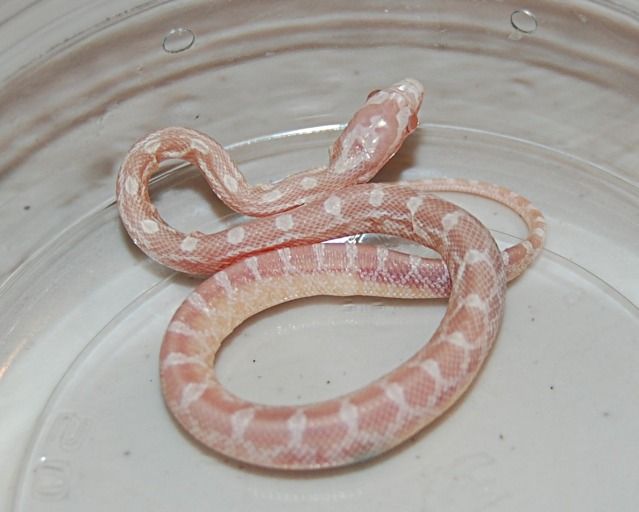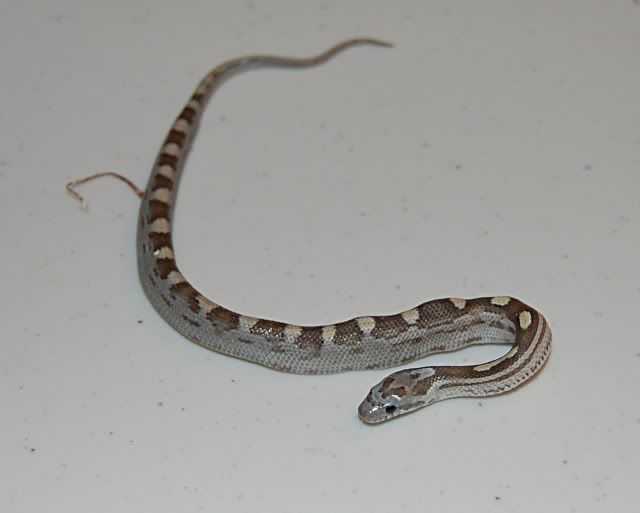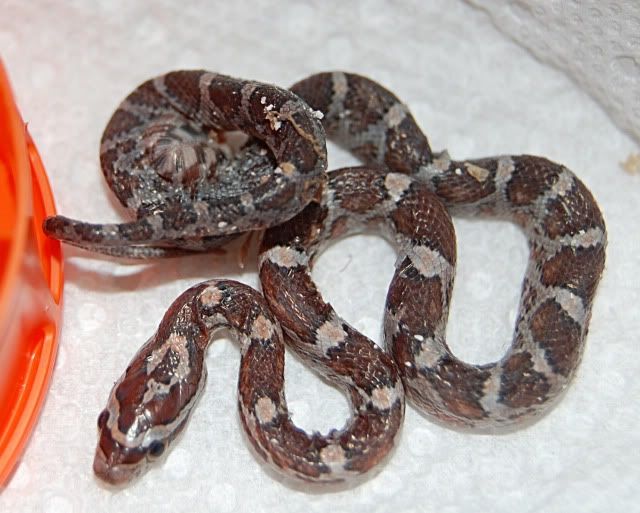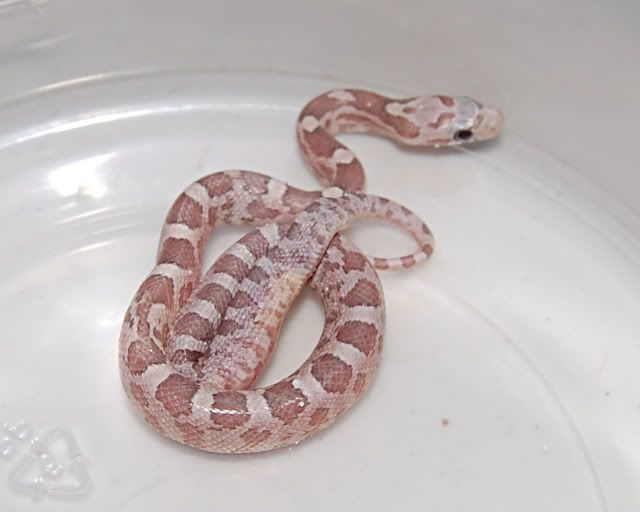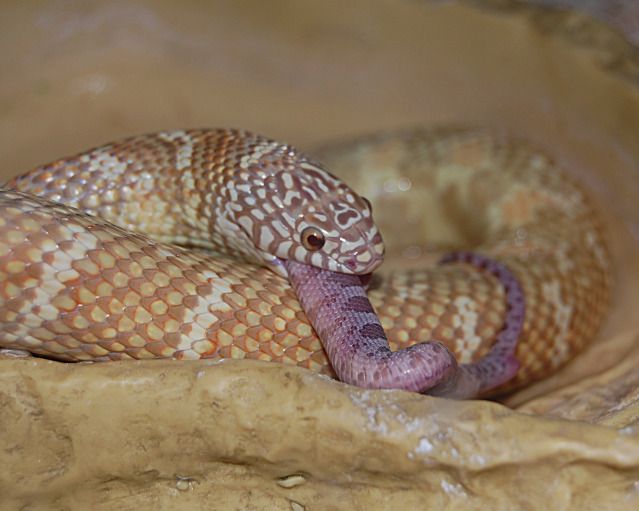Chip
ΜΟΛΩΝ ΛΑΒ&
It’s often said corn snakes are like potato chips, it’s hard to stop at one. There are so many colors and patterns and combinations that it makes these low-maintenance pets practically BEG to be collected! Thermostats and racks are becoming more economical, caging is easy to make, and besides –you could feed 4 snakes by mail-ordering mice for the price of feeding one when buying retail! Well, while that is false logic, it would be disingenuous of me as a hobby breeder to suggest you not breed corn snakes! And anyone who loves them should experience the joy of the day eggs start to pip. When that first head comes out, it’s a great feeling even if it’s a normal. When it’s your long-awaited target morph; it’s as exciting to us snake-nerds as a first kiss. However, that can be as small of a part of snake-keeping as a kiss is to marriage! Let’s examine.
Health:
There is some inherent risk to the health of your animals when you breed them. Breeding offers little risk to the male in my experience -although I have heard of crushed small males or severed hemipenes, I can say with certainty it is not common. The real troubles are almost always with the female. Eggs can really take something out of the corn that isn’t in optimal health. I have females that double clutch every year and bounce right back, and I probably have a half dozen girls in my collection that had complications and will never be bred again. Greater in number still are the females that died after dystocia –several of which had professional veterinary care and were caught early. Make no mistake, breed enough reptiles and you will encounter complications. This brings me to my next point.
Know a good reptile vet:
A lot of vets who see exotics apparently missed most of their classes on things with scales. They hear what you tell them is going wrong, get on Google, and perhaps call a colleague and write an RX. Maybe that’s a little harsh, but few seem to keep any reptiles themselves or have much interest in the animals. A good one is a priceless asset.
Feeding babies… so you went from 2 corns snakes to 26:
If you browse the Health Issues/Feeding Problems sub-forum, you no doubt have noticed all those threads titled “My baby won’t eat!” Well, some babies give you fits. You will probably invest a good chunk of time in your eating, pooping, growing machines that aren’t giving you problems. The ones that are can really take some time, though. Many would argue these animals should be culled. Others find that once a feeding trigger is found, the animal eats like it is supposed to and contend there was never anything wrong. Either way, you can make the choice to destroy baby snakes, spend an awful lot of time trying to get them to eat, or give them away/sell them cheap to let someone else try. No perfect options.
Why are you breeding?/Selling babies/culling
Let no one mislead you that breeding snakes is lucrative. I know some people cashed in on few ball python mutations, and some are trying to with hognose. But this is a hobby for me, although I am unfortunately drawn to the most expensive mutations. Some years I have more than paid for mice, and got to swap for a couple nice snakes along the way. That’s a banner year! But I have no illusions of corn snakes ever making my house payment. But before breeding, you still should think about the monetary value of what you produce. Normals, amels, anery, snow, hypo, ghost, and striped and motleys thereof are morphs I have seen for as cheap as five dollars at a reptile show. That is flat out disposable pet territory, and the main reason I would encourage people not to breed any snakes without intent. What purpose does it serve you or the hobby to pump a few more inexpensive common morphs into an already saturated market? Ask yourself why your snakes should be bred. I have over 80 and last year paired up 4 -and bigger breeders often have even smaller percentages of who makes the cut any given year.
On the flip side, there are higher end morphs. They are worth way more than five bucks; they’ll fly off your table, right? It is possible, some would say more likely, that you will run into “where can I find someone to buy these things?” There’s here, Fauna, and other sites, sure. But my name is Chip Bridges, who is going to buy a scaleless tessera palmetto stripe from me when guys who have written books are selling the same thing? Well, when expensive mutations don't sell for me, I keep my high end baby. Someone will want them as yearlings or adults, and while I might not get what I wanted out of them, older snakes are always more valuable to other breeders. Besides, you may just get attached to it.
But wait, I almost forgot the most uncomfortable, unpleasant, and downright sucky part of this whole breeding hobby. We have only been talking about the perfect babies that can be brought to market. Some babies fail to thrive even with your best efforts. I have always preferred feeding these to another reptile over letting them waste away. Freezing is another way to end their lives, but starving/wasting away is never a good option. Also, you will on occasion produce some with problems; one eye, a spinal kink, a misaligned jaw, etc. It is my opinion that these animals should be culled. Even if it is suspected incubation issue, there is no reason to let less than perfect specimens of a snake as common as our beloved corns breed. Nature is cruel in her unforgiving quest to let only the best adapted survive. The very least we can do for the captive lineage -as well as those who come after us in the hobby -is allow no hybrids or deformed animals into the gene pool, to the best of our abilities.
I will reiterate. No snake with a kink or deformity should ever be bred. Most reputable breeders share my belief that they should either be culled (killed) or kept as pets for the remainder of their lives. Giving them away as pets does not ensure they will not be bred, once they are out of your possession, they are out of your control and greed and ignorance are powerful forces.
Final thought:
Just because they’re laid doesn’t mean you have to incubate. It’s easy! I threw away a clutch of 21 eggs from tessera het ghost to anery het hypo just last month. Okay, that one was hard.
Now that you’ve had all that to think about, here are some thoughts on picking a girl.
The female breeder:
Hopefully you will also have the male figured out, and will know what you are making. Study genetics, the corn snake calculator, etc. While we think it’s cute when people hoped to get butter stripes by breeding a butter to a stripe and got all normals, you don’t want it happening to you.
Up to size:
You’ll hear it called around here “the rule of 3’s.” That’s 3 years, 3 feet, 300 grams. And you've probably heard of people getting their females up to size in two years without issue. This is sometimes done with expensive cutting edge mutations, and there is probably a Palmetto not even hungry from her last meal being offered a fuzzy mouse as you read this! I find age & length mean very little, the female just needs to be “girthy” and have good muscle tone. That’s not always ideal to pull off in a two year old –in fact, most of my ‘09s I opted not to breed this year. I know folks will tell me they’ve done it at 16 months, but I have never seen the female that age I thought was ready. Honestly, at 300 grams, that is still smaller than I prefer to breed a corn. The ones that take a beating from laying eggs are almost always smaller girls, or ones with poor muscle tone. If in doubt, waiting another year will not hurt.
There is simply not time here, nor is it the scope of this article to go into genetics, brumation, conditioning the female, breeding, gestation, egg laying, dystocia, incubation, feeding babies, problem feeders, determining gender, marketing, selling, and so forth. If you have any questions, please ask. There are a lot of folks with a lot of years keeping a lot of snakes on this forum who will give you great information and advice. We don’t agree on everything, and that’s a great thing! However, I do think one thing we can all agree on is that breeding these magnificent animals should be done with a purpose. I hope that anyone who enjoys keeping corns and want to take the next step does so consciously and conscientiously. We can all agree that the snakes deserve that!
I figured I'd float this in my forum and see what other breeders think before assuming "my" way is worthy of a sticky. From the "egg adventure" thread, it seemed a lot of people wanted an easy to find guideline of who/what is desirable to breed. These are my thoughts on the topic.
Health:
There is some inherent risk to the health of your animals when you breed them. Breeding offers little risk to the male in my experience -although I have heard of crushed small males or severed hemipenes, I can say with certainty it is not common. The real troubles are almost always with the female. Eggs can really take something out of the corn that isn’t in optimal health. I have females that double clutch every year and bounce right back, and I probably have a half dozen girls in my collection that had complications and will never be bred again. Greater in number still are the females that died after dystocia –several of which had professional veterinary care and were caught early. Make no mistake, breed enough reptiles and you will encounter complications. This brings me to my next point.
Know a good reptile vet:
A lot of vets who see exotics apparently missed most of their classes on things with scales. They hear what you tell them is going wrong, get on Google, and perhaps call a colleague and write an RX. Maybe that’s a little harsh, but few seem to keep any reptiles themselves or have much interest in the animals. A good one is a priceless asset.
Feeding babies… so you went from 2 corns snakes to 26:
If you browse the Health Issues/Feeding Problems sub-forum, you no doubt have noticed all those threads titled “My baby won’t eat!” Well, some babies give you fits. You will probably invest a good chunk of time in your eating, pooping, growing machines that aren’t giving you problems. The ones that are can really take some time, though. Many would argue these animals should be culled. Others find that once a feeding trigger is found, the animal eats like it is supposed to and contend there was never anything wrong. Either way, you can make the choice to destroy baby snakes, spend an awful lot of time trying to get them to eat, or give them away/sell them cheap to let someone else try. No perfect options.
Why are you breeding?/Selling babies/culling
Let no one mislead you that breeding snakes is lucrative. I know some people cashed in on few ball python mutations, and some are trying to with hognose. But this is a hobby for me, although I am unfortunately drawn to the most expensive mutations. Some years I have more than paid for mice, and got to swap for a couple nice snakes along the way. That’s a banner year! But I have no illusions of corn snakes ever making my house payment. But before breeding, you still should think about the monetary value of what you produce. Normals, amels, anery, snow, hypo, ghost, and striped and motleys thereof are morphs I have seen for as cheap as five dollars at a reptile show. That is flat out disposable pet territory, and the main reason I would encourage people not to breed any snakes without intent. What purpose does it serve you or the hobby to pump a few more inexpensive common morphs into an already saturated market? Ask yourself why your snakes should be bred. I have over 80 and last year paired up 4 -and bigger breeders often have even smaller percentages of who makes the cut any given year.
On the flip side, there are higher end morphs. They are worth way more than five bucks; they’ll fly off your table, right? It is possible, some would say more likely, that you will run into “where can I find someone to buy these things?” There’s here, Fauna, and other sites, sure. But my name is Chip Bridges, who is going to buy a scaleless tessera palmetto stripe from me when guys who have written books are selling the same thing? Well, when expensive mutations don't sell for me, I keep my high end baby. Someone will want them as yearlings or adults, and while I might not get what I wanted out of them, older snakes are always more valuable to other breeders. Besides, you may just get attached to it.
But wait, I almost forgot the most uncomfortable, unpleasant, and downright sucky part of this whole breeding hobby. We have only been talking about the perfect babies that can be brought to market. Some babies fail to thrive even with your best efforts. I have always preferred feeding these to another reptile over letting them waste away. Freezing is another way to end their lives, but starving/wasting away is never a good option. Also, you will on occasion produce some with problems; one eye, a spinal kink, a misaligned jaw, etc. It is my opinion that these animals should be culled. Even if it is suspected incubation issue, there is no reason to let less than perfect specimens of a snake as common as our beloved corns breed. Nature is cruel in her unforgiving quest to let only the best adapted survive. The very least we can do for the captive lineage -as well as those who come after us in the hobby -is allow no hybrids or deformed animals into the gene pool, to the best of our abilities.
I will reiterate. No snake with a kink or deformity should ever be bred. Most reputable breeders share my belief that they should either be culled (killed) or kept as pets for the remainder of their lives. Giving them away as pets does not ensure they will not be bred, once they are out of your possession, they are out of your control and greed and ignorance are powerful forces.
Final thought:
Just because they’re laid doesn’t mean you have to incubate. It’s easy! I threw away a clutch of 21 eggs from tessera het ghost to anery het hypo just last month. Okay, that one was hard.
Now that you’ve had all that to think about, here are some thoughts on picking a girl.
The female breeder:
Hopefully you will also have the male figured out, and will know what you are making. Study genetics, the corn snake calculator, etc. While we think it’s cute when people hoped to get butter stripes by breeding a butter to a stripe and got all normals, you don’t want it happening to you.
Up to size:
You’ll hear it called around here “the rule of 3’s.” That’s 3 years, 3 feet, 300 grams. And you've probably heard of people getting their females up to size in two years without issue. This is sometimes done with expensive cutting edge mutations, and there is probably a Palmetto not even hungry from her last meal being offered a fuzzy mouse as you read this! I find age & length mean very little, the female just needs to be “girthy” and have good muscle tone. That’s not always ideal to pull off in a two year old –in fact, most of my ‘09s I opted not to breed this year. I know folks will tell me they’ve done it at 16 months, but I have never seen the female that age I thought was ready. Honestly, at 300 grams, that is still smaller than I prefer to breed a corn. The ones that take a beating from laying eggs are almost always smaller girls, or ones with poor muscle tone. If in doubt, waiting another year will not hurt.
There is simply not time here, nor is it the scope of this article to go into genetics, brumation, conditioning the female, breeding, gestation, egg laying, dystocia, incubation, feeding babies, problem feeders, determining gender, marketing, selling, and so forth. If you have any questions, please ask. There are a lot of folks with a lot of years keeping a lot of snakes on this forum who will give you great information and advice. We don’t agree on everything, and that’s a great thing! However, I do think one thing we can all agree on is that breeding these magnificent animals should be done with a purpose. I hope that anyone who enjoys keeping corns and want to take the next step does so consciously and conscientiously. We can all agree that the snakes deserve that!
I figured I'd float this in my forum and see what other breeders think before assuming "my" way is worthy of a sticky. From the "egg adventure" thread, it seemed a lot of people wanted an easy to find guideline of who/what is desirable to breed. These are my thoughts on the topic.
Last edited:



